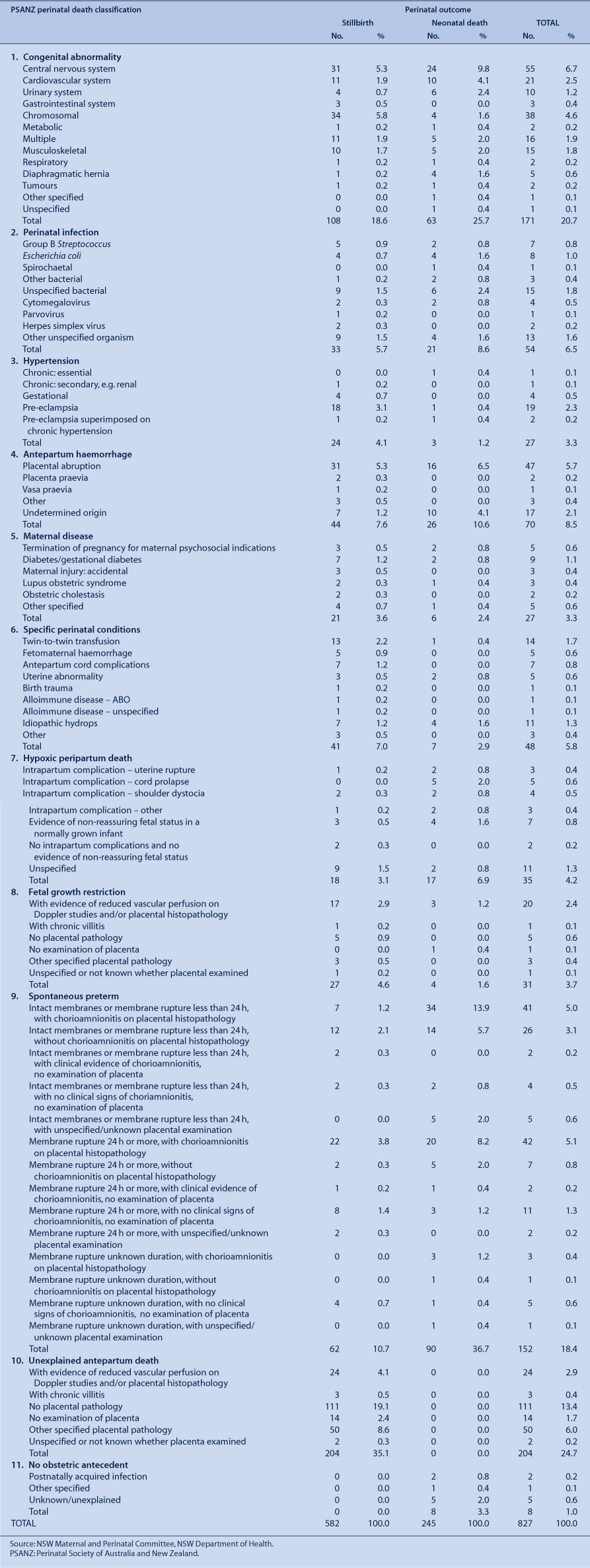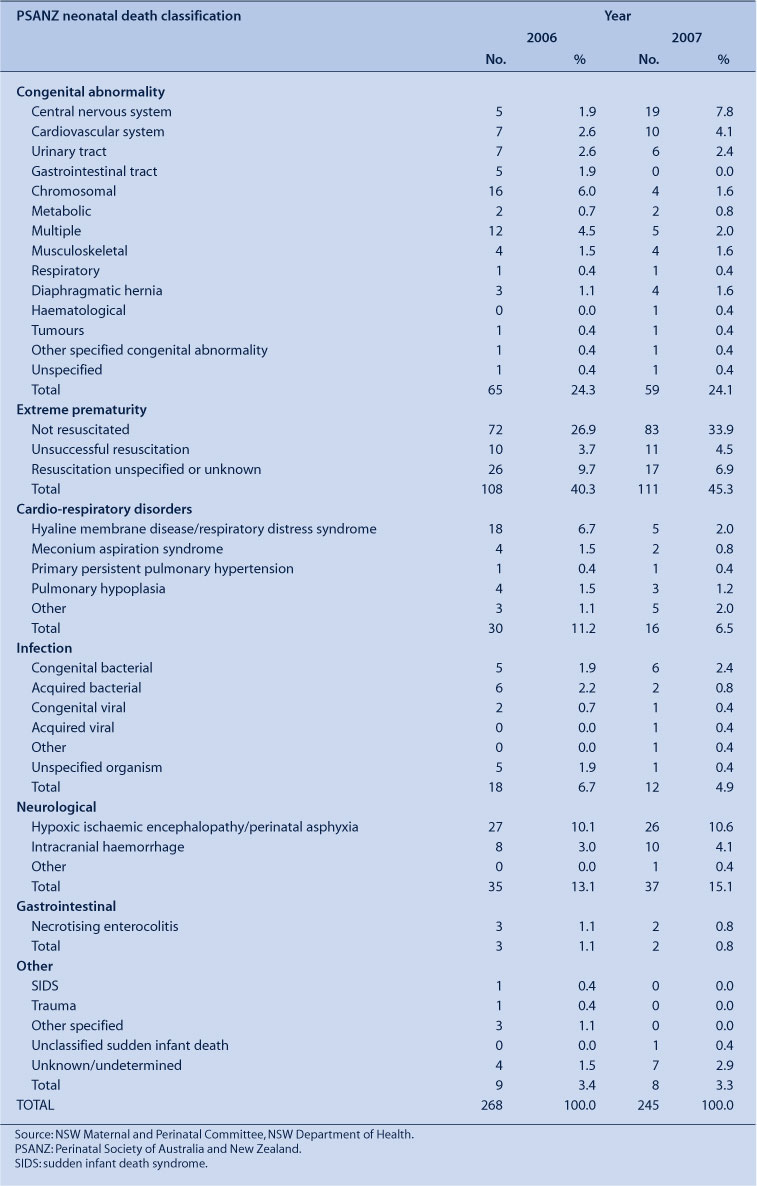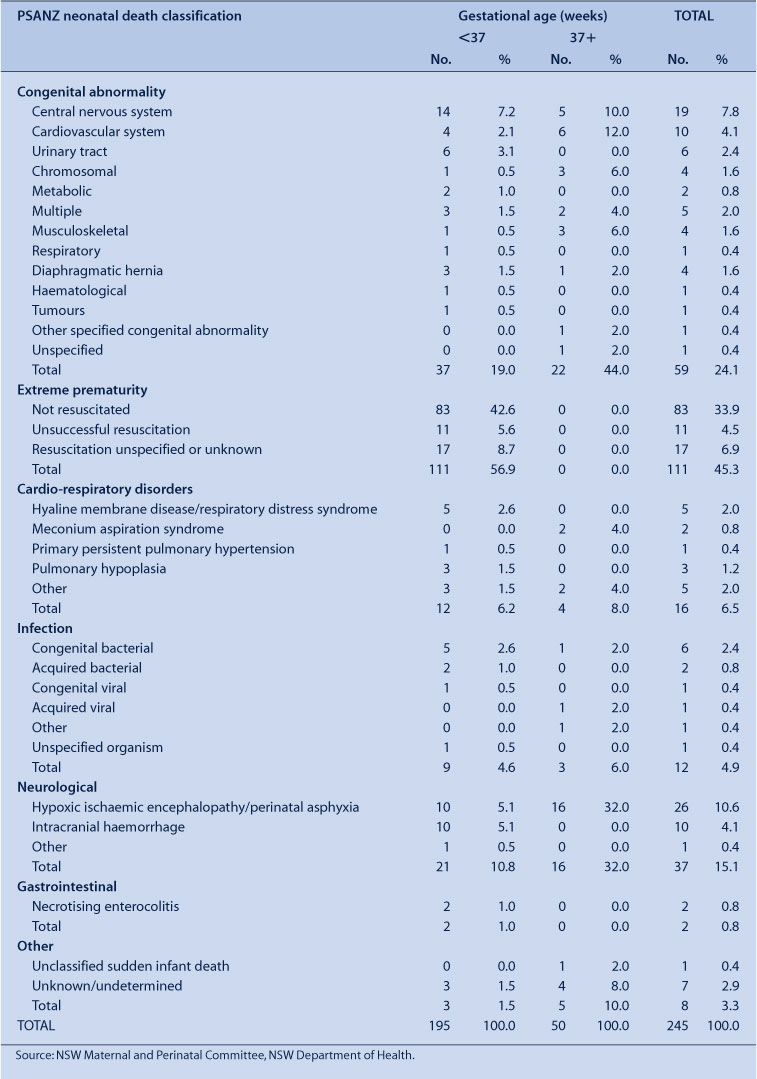10. Perinatal deaths
NSW Public Health Bulletin 21(1) 102-109 https://doi.org/10.1071/NB10S10
Published: 24 June 2010
Review of perinatal deaths 2007
This chapter presents the results of perinatal death reviews carried out by the NSW Maternal and Perinatal Committee, which is a quality assurance committee established under the NSW Health Administration Act 1982. The Committee is privileged under the Act to carry out confidential reviews of maternal and perinatal deaths.
NSW Department of Health Policy Directive No. 2006_007 describes hospital procedures for review and reporting of perinatal deaths.1 In 2006 and 2007, the Maternal and Perinatal Committee carried out reviews of perinatal deaths occurring among fetuses or infants of at least 20 weeks gestation or at least 400 g birth weight, bringing the Committee’s review process in line with the criteria used by the NSW Midwives Data Collection (MDC) since 2006 for reporting of births.
Perinatal deaths were reviewed by the Committee’s Perinatal Outcomes Working Party. Both stillbirths and neonatal deaths were classified according to an obstetric cause-specific classification, the Perinatal Society of Australia and New Zealand Perinatal Death Classification (PSANZ–PDC). Neonatal deaths were also classified by neonatal cause according to the Perinatal Society of Australia and New Zealand Neonatal Death Classification (PSANZ–NDC).2
There were 868 perinatal deaths of at least 20 weeks gestation or at least 400 g birth weight reported to the MDC in 2007. Confidential reports on 827 deaths were reviewed. Of the 629 stillbirths reported to the MDC, reviews were carried out on 582 (92.5%). The MDC was notified of 239 neonatal deaths. Reviews were carried out on 245 neonatal deaths, which include neonatal deaths that occurred after discharge or transfer from the hospital of birth.
Trends in causes of perinatal death
Causes of perinatal death in 2006 and 2007 are shown in Table 111. The overall pattern of deaths was similar for both years. The percentage of deaths due to congenital abnormalities fell slightly from 22.5% in 2006 to 20.7% in 2007; whereas there was an increase in the percentage of deaths attributed to unexplained antepartum, from 19.4% to 24.7%. Almost one in five deaths was due to spontaneous preterm birth for both years.

|
Causes of perinatal death 2007
Perinatal deaths were classified according to the PSANZ–PDC, which identifies the single most important factor that led to the chain of events that resulted in the death.
1. Congenital abnormality
In 2007, congenital abnormalities as a group were the second most common cause of perinatal death, responsible for 171 deaths (Table 112). The most common abnormalities were chromosomal (n = 38; 22.2%). Of these, 13 were trisomy 18, 13 were trisomy 21, two were trisomy 13, and two were Turner syndrome.

|
Fifty-five deaths were associated with abnormalities of the central nervous system (32.2%) and included 24 deaths due to neural tube defects and 13 deaths associated with congenital hydrocephalus. Twenty-one deaths were associated with abnormalities of the cardiovascular system, which included 10 cases of hypoplastic left-heart syndrome, two cases of transposition of the great vessels, one case of hypoplastic left ventricle, one case of hypoplastic right heart and one case of coarctation of the aorta.
Five deaths were associated with congenital diaphragmatic hernia, and 16 deaths were due to multiple abnormalities not associated with a chromosomal abnormality.
2. Perinatal infection
Fifty-four deaths (6.5%) were found to be due to infection, of which 33 were stillbirths and 21 were neonatal deaths. For 33 deaths, there was an associated chorioamnionitis. The most common infective organisms were Escherichia coli (n = 8) and group B Streptococcus infection (n = 7). Four perinatal deaths followed congenital cytomegalo-virus infection, one followed a parvovirus infection, and one followed a herpes simplex infection.
3. Hypertension
Twenty-seven deaths (3.3%) were considered to be due to maternal hypertension. There were 24 stillbirths and three neonatal deaths. The majority (n = 19) occurred in mothers with pre-eclampsia. There were two deaths attributed to chronic hypertension, four to gestational hypertension, and two to pre-eclampsia superimposed on pre-existing hypertension.
4. Antepartum haemorrhage
Seventy deaths were due to antepartum haemorrhage, of which 47 were due to placental abruption, two were due to placenta praevia, and one was due to vasa praevia. Of the 47 deaths due to placental abruption, seven were associated with maternal hypertension.
5. Maternal disease
Twenty-seven deaths were attributed to other maternal conditions, including diabetes (n = 9), maternal injury (n = 3), lupus obstetric syndrome (n = 3) and termination of pregnancy (n = 5).
6. Specific perinatal conditions
Twin-to-twin transfusion accounted for the majority of deaths in this group (n = 14), followed by idiopathic hydrops (n = 11), antepartum cord complications (n = 7), uterine abnormality (n = 5) and fetomaternal haemorrhage (n = 5).
7. Hypoxic peripartum death
There were 35 deaths associated with peripartum hypoxia. Five deaths followed cord prolapse, four deaths were associated with shoulder dystocia and three deaths followed uterine rupture. Eight deaths occurred before the onset of labour, nine during labour and one at an unspecified time prior to birth. The remaining 17 deaths occurred in the neonatal period.
8. Fetal growth restriction
In 31 cases, the main cause of death was considered to be fetal growth restriction (FGR). Of these, 27 were stillbirths and four were neonatal deaths. FGR is defined as less than the tenth percentile of birth weight for gestational age, with no major congenital abnormalities. If a maternal or fetal cause of FGR was known, then the cause of death was classified to the underlying cause of the FGR. Stillbirths with evidence of maceration were not classified as FGR, unless there was evidence of growth restriction on serial ultrasound during pregnancy.
9. Spontaneous preterm
There were 152 (18.4%) perinatal deaths associated with spontaneous preterm birth, which comprises normally formed and appropriately grown babies born before 37 weeks gestation. Of these, 62 (40.8%) were stillbirths and 90 (59.2%) were neonatal deaths.
Of all deaths in this category, 84 (55.3%) were at less than 23 weeks gestation, 54 (35.5%) were at 23–25 weeks gestation, and 14 (9.2%) occurred between 26 and 36 weeks gestation. Fifty-six deaths (36.8%) were associated with membrane rupture of 24 h or more.
10. Unexplained antepartum death
Of the 204 unexplained stillbirths, 123 (60.3%) were low birth weight babies and 130 (63.7%) were premature. A variety of associated maternal conditions were reported in this group, including multiple pregnancy (n = 14 deaths), maternal hypertension (n = 15), diabetes (n = 8), and thyrotoxicosis (n = 2). Post-mortem examination was carried out in 80 cases (39.2%). Placental histopathology results were provided for 181 unexplained antepartum deaths (88.7%).
11. No obstetric antecedent
No obstetric cause of death was identified for eight neonatal deaths. There were two deaths due to postnatally acquired infection, one death due to primary persistent pulmonary hypertension and five deaths were unexplained.
Obstetric cause of perinatal death by hospital service level
Obstetric service levels are described in the Explanatory Notes of the Methods section (p. 11). The majority of perinatal deaths occurred in Level 6 hospitals (45.6%, Table 113). The proportion of unexplained intrauterine deaths was substantially lower in Level 6 hospitals than in other hospitals, possibly because of better access to perinatal post-mortem services. The proportion of deaths associated with congenital abnormalities was highest in Level 6 hospitals, reflecting patterns of referral for diagnosis and treatment.

|
Time of death 2007
Of the 827 perinatal deaths reviewed for 2007, 377 (45.6%) occurred before the onset of labour, 72 (8.7%) occurred during labour, 131 (15.8%) occurred at an unknown time before birth, and 247 (29.8%) were neonatal deaths.
Of the 72 deaths that occurred during labour, 40 (55.6%) occurred at less than 23 weeks gestation, 16 (22.2%) occurred at 23–25 weeks gestation, and 16 (22.2%) occurred at 26 weeks or more.
Neonatal causes of death
In 2007, extreme prematurity (26 weeks gestation or less) was the most common cause of neonatal death, accounting for 45.3% of all neonatal deaths in 2007 (Table 114). Congenital abnormalities were the next most common cause of neonatal death, accounting for about one in four deaths.

|
Of the 245 neonatal deaths, 195 (79.6%) were preterm (Table 115). Among the 50 neonatal deaths among babies born at term, 22 deaths were due to congenital malformations and a further 16 were due to neurological conditions.

|
Perinatal deaths associated with maternal drug dependency and abuse 2007
No perinatal deaths were directly attributed to maternal drug dependency or drug abuse in 2007. Nine deaths occurred among mothers who had a history of drug dependency or abuse, but drug use was not considered to be the main cause of death.
Post-mortem examination 2007
Post-mortem examination is valuable in ascertaining or confirming the cause of death, identifying additional factors that may have contributed to the death, and counselling parents about the cause of death. Post-mortem examinations were carried out for 283 (34.2%) deaths, including 227 stillborn infants (39.0% of all reported stillbirths) and 56 neonatal deaths (22.9% of all reported neonatal deaths). Placental histopathology was carried out for 665 perinatal deaths (80.4%).
[1]
[2]


